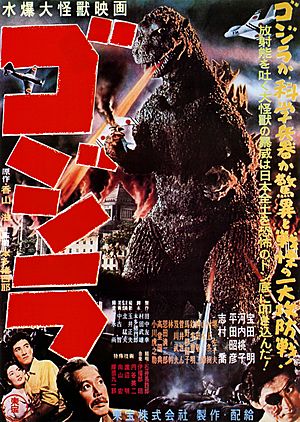Godzilla (1954 movie) facts for kids
Quick facts for kids Godzilla |
|
|---|---|

The 1954 Japanese movie poster
|
|
| Directed by | Ishirō Honda |
| Produced by | Tomoyuki Tanaka |
| Screenplay by | Ishirō Honda Takeo Murata |
| Story by | Shigeru Kayama |
| Starring | Akira Takarada Momoko Kōchi Akihiko Hirata Takashi Shimura |
| Music by | Akira Ifukube |
| Cinematography | Masao Tamai |
| Editing by | Kazuji Taira |
| Studio | Toho |
| Distributed by | RKO |
| Release date(s) | November 3, 1954 |
| Running time | 96 minutes |
| Country | |
| Language | Japanese |
| Budget | $1,500,000 |
| Money made | $2,250,000 |
Godzilla (ゴジラ, Gojira) is a famous 1954 Japanese science fiction movie. It's known for introducing the giant monster called Godzilla. This movie was produced by Tomoyuki Tanaka and directed by Ishirō Honda.
The film was distributed by Toho and became the first of many "kaiju" movies. A kaiju is a Japanese word for a giant monster. The story is about Godzilla, a huge creature that attacks Japan.
The movie's scary opening scene, where a ship called the Eiko Maru is destroyed, was inspired by real events. In 1954, the U.S. tested a hydrogen bomb on Bikini Atoll. This event led to ideas for the film, like survivors having radiation burns.
Godzilla received great reviews from critics. It still has a high rating of 94% on Rotten Tomatoes, a website that collects movie reviews.
Contents
The Story of Godzilla
The movie begins with a Japanese fishing boat, the Eiko Maru, being attacked and sunk near Odo Island. Another rescue boat is also destroyed. Villagers on Odo Island believe a legendary monster called Godzilla is responsible.
Soon, a scientist named Dr. Kyohei Yamane visits the island. He finds a huge footprint and a strange radioactive creature. He realizes that Godzilla is a giant dinosaur-like monster. This creature was awakened and mutated by nuclear radiation.
Godzilla then attacks Japan, causing massive destruction in Tokyo. The military tries to stop it, but their weapons are useless against the monster. Buildings are destroyed, and many people are hurt.
A young scientist, Daisuke Serizawa, has a secret weapon. It's called the "Oxygen Destroyer." This invention can destroy oxygen in water, killing living things. However, Serizawa is afraid to use it. He fears it could be used as a terrible weapon of war.
Eventually, Serizawa agrees to use the Oxygen Destroyer to stop Godzilla. He goes underwater with the main characters to deploy it. He sacrifices himself to ensure the weapon is never used again. Godzilla is defeated, but the movie ends with a warning. It suggests that if nuclear tests continue, other Godzillas might appear.
Main Characters
The movie features several important characters who try to understand and stop Godzilla.
Key People in the Film
- Hideto Ogata: Played by Akira Takarada, he is a brave salvage ship captain. He is in love with Emiko Yamane.
- Emiko Yamane: Played by Momoko Kōchi, she is Dr. Yamane's daughter. She knows about Dr. Serizawa's secret weapon.
- Daisuke Serizawa: Played by Akihiko Hirata, he is a brilliant but troubled scientist. He invented the Oxygen Destroyer.
- Dr. Kyohei Yamane: Played by Takashi Shimura, he is a respected paleontologist. He is the first to study Godzilla.
Who Played Godzilla?
The monster Godzilla was played by two actors in a suit.
- Haruo Nakajima was the main actor inside the Godzilla suit. He also played a reporter.
- Katsumi Tezuka was a stunt double for Godzilla. He also played Editor Yamada.
How the Movie Was Made
The movie was made by Toho, a famous Japanese film studio. It was a big project for its time.
Special Effects
Instead of using stop-motion animation, the filmmakers used a technique called "suitmation." This is where an actor wears a detailed monster suit. They then walk through miniature sets of cities. This made Godzilla feel very real and huge.
Music and Sound
The music for Godzilla was composed by Akira Ifukube. His powerful and dramatic score helped make the monster even more terrifying. The iconic roar of Godzilla was created by rubbing a resin-coated glove along the strings of a double bass.

